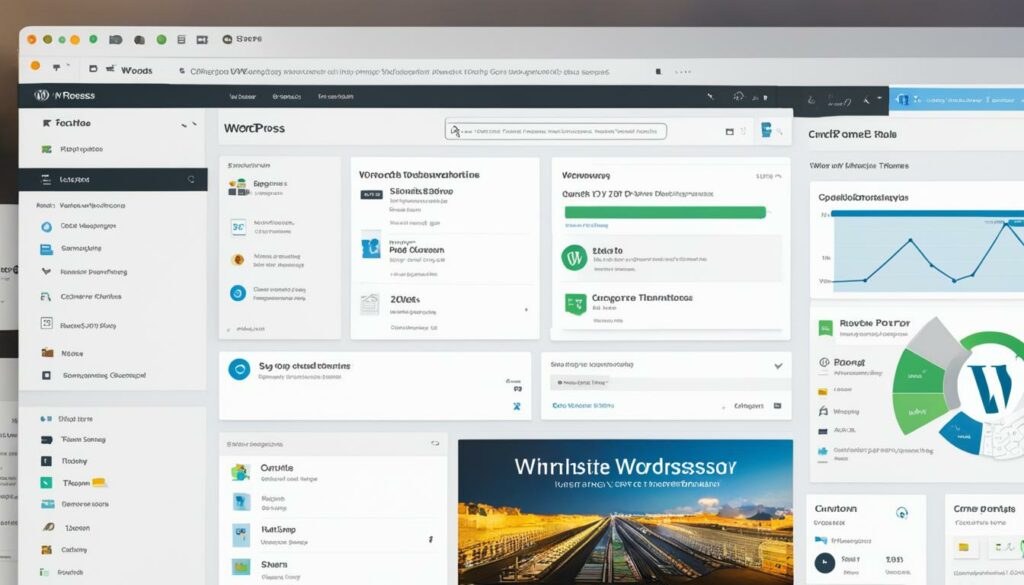Have you ever wondered how your browser knows where to take you when you type in a website’s name? Understanding the basics of the DNS Server is crucial to understanding the process that leads you to the website you want.
The domain name system, or DNS for short, functions like a phonebook for the internet. Every website has a unique IP address, but memorizing a sequence of numbers for every site you visit would be impossible. Instead, the DNS Server translates the domain name you enter into its corresponding IP address, helping you navigate the web with ease.
Key Takeaways:
- The DNS Server is essential to internet connectivity, translating domain names into IP addresses.
- The DNS functions like a phonebook for the internet.
- Every website has a unique IP address, which the DNS Server helps translate for you.
- Memorizing IP addresses for every website would be impossible, making the DNS an essential tool for browsing the web.
Exploring the DNS Infrastructure
When you type in a website name, such as www.example.com, your device sends a DNS query to a DNS resolver, which in turn sends the query to a DNS server. The server then translates the website name into an IP address, allowing your device to connect to the website.
However, the DNS infrastructure is much more complex than that. It consists of multiple types of servers, each with its own role to play in ensuring seamless internet connectivity. These servers work together to form the internet infrastructure that powers the modern digital world.
One of the key players in the DNS infrastructure is the DNS resolver. This server responds to DNS queries from your device and manages the communication with other DNS servers to ensure that accurate responses are delivered in a timely manner. Without DNS resolvers, accessing websites would be much slower and more complicated.
Another important component of the DNS infrastructure is the DNS root server. These servers act as the starting point for all DNS queries. They are responsible for directing queries to the appropriate top-level domain servers, such as .com or .org. Additionally, there are authoritative DNS servers that store domain name records for specific websites. When a DNS query is received, an authoritative DNS server responds with the IP address associated with the requested domain name.
Internet Infrastructure and DNS
The DNS infrastructure is closely linked to the overall internet infrastructure. In fact, DNS servers are a critical part of the internet’s backbone and make it possible for devices to communicate with each other across the world. The internet infrastructure is made up of servers, routers, and other devices that work together to create a globally connected network.
The DNS infrastructure plays a vital role in connecting devices to the internet and directing internet traffic. It ensures that DNS queries and responses are delivered accurately and efficiently, allowing you to access websites and other online resources with ease. Without DNS servers and the broader internet infrastructure, the modern digital world would not be possible.
Understanding DNS Queries and Lookups
When you enter a URL in your web browser, your device sends a DNS query to a DNS server to translate the domain name into an IP address. This process is known as a DNS lookup and involves several steps that allow you to access websites and other online resources.
The DNS configuration is essential for enabling accurate DNS queries and responses. It involves setting up your device to use a specific DNS server or configuration for resolving queries. By customizing your DNS settings, you can improve internet speeds and security.
The actual DNS query process involves several steps, including:
- Your device sends a DNS query to a DNS resolver, which is a server that handles DNS requests on your behalf.
- The DNS resolver sends the request to a root DNS server, which helps to locate the DNS server responsible for the top-level domain (TLD) you’re looking for.
- The TLD DNS server then directs the request to the authoritative DNS server for the domain you’re looking for.
- The authoritative DNS server responds to the request with the IP address associated with the domain name.
- Your device can now connect to the server hosting the website or resource you requested, and your web browser loads the content.
Understanding how DNS queries and lookups work is important for troubleshooting internet connectivity issues and optimizing your online experience.
Conclusion
Now that you have a better understanding of what a DNS Server is and how it works within the domain name system, you can appreciate its significance in facilitating internet connectivity. DNS Servers play a pivotal role in translating domain names into IP addresses, allowing you to access websites and online resources with ease.
Without DNS Servers, the internet as we know it would not exist, and browsing the web would be a much more complicated task. By streamlining the process of DNS queries and lookups, DNS Servers ensure seamless communication between devices and enhance your overall online experience.
So the next time you browse the web and wonder how you can access websites through domain names, remember that it’s all thanks to DNS Servers. With this newfound knowledge, you’ll be able to appreciate the significance of DNS infrastructure and the role it plays in making the internet accessible to millions of people worldwide.
If you’re curious about exploring the world of DNS Servers further, there are various resources available online that can help you understand the intricacies of DNS configuration and management. Keep exploring, and you’ll be amazed at how much you can learn about this fascinating technology!
Thank you for taking the time to learn about DNS Servers and their role in the domain name system. We hope this article has been informative and engaging, and we look forward to bringing you more exciting insights into the world of technology.
Remember, DNS Servers are the backbone of the internet, and their significance cannot be overstated. Whether you’re a website owner, an internet user, or a tech enthusiast, understanding DNS Servers is a must. So keep exploring, and have fun!
FAQ
What is a DNS server?
A DNS server, short for Domain Name System server, is a crucial component of the internet infrastructure. It acts as a translator, converting domain names (such as www.example.com) into their corresponding IP addresses (such as 192.168.1.1) that computers use to communicate with each other.
How does a DNS server function in the domain name system?
A DNS server functions by receiving DNS queries from DNS resolvers and returning the corresponding DNS responses. When you type a website’s domain name into your browser, your computer sends a DNS query to a DNS server, requesting the IP address associated with that domain name. The DNS server then provides the IP address, allowing your browser to establish a connection with the website.
What is the role of DNS resolvers in the overall DNS infrastructure?
DNS resolvers play a crucial role in the DNS infrastructure as they are responsible for initiating DNS queries on behalf of client devices. They receive DNS queries from devices, such as your computer or smartphone, and forward them to appropriate DNS servers to retrieve the necessary IP address information. Once the DNS resolver receives the response from the DNS server, it returns the IP address to the client device, enabling it to connect to the desired website or online resource.
How do DNS queries and lookups work?
DNS queries involve the process of a client device, such as your computer, sending a request to a DNS resolver to resolve a domain name into the associated IP address. The DNS resolver then sends a series of recursive queries to different DNS servers, starting from the authoritative DNS server for the domain in question, until it receives a response with the IP address. Once the DNS resolver obtains the IP address, it sends it back to the client device, allowing it to establish a connection with the desired website or resource.
How does DNS configuration affect the process of domain name to IP address translation?
DNS configuration involves setting up the appropriate DNS records, such as A records or CNAME records, to map domain names to IP addresses. When a DNS query is received by a DNS server, it checks its configuration to determine which IP address is associated with the requested domain name. Proper DNS configuration ensures accurate translation of domain names into IP addresses, enabling seamless communication and access to online resources.











